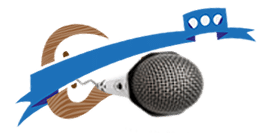The Counterculture Movement
Counterculture refers to an anti-establishment cultural phenomenon that started in the United States and then spread throughout much of the Western world between the early 1960s and the mid-1970s. New York City and San Francisco were the center of this culture in the United States. The Civil Rights Movement helped this movement to gain momentum. As the 1960s progressed, a wide degree of social tensions developed with the many issues going on such as the U.S. involvement in Vietnam, women’s right and different interpretations of exactly what constituted the American Dream.
A new movement unfolded that celebrated experimentation, the rise of the hippies and leading alternative lifestyles. This embracing of creativity is particularly notable in the works of British Invasion bands such as the Beatles, and filmmakers whose works became far less restricted by censorship. In addition to the trendsetting Beatles, many other creative artists, authors, and thinkers, within and across many disciplines, helped define the counterculture movement.
Though there were other movements before the Counterculture movement, several factors distinguished the counterculture of the 1960s from the anti-authoritarian movements of previous eras. The post-World War II “baby boom” created a generation of Americans who wanted to rethink the direction of their democratic society. Post-war affluence allowed many of the counterculture generation to move beyond a focus on the provision of the material necessities of life that had preoccupied their Depression-era parents.
The counterculture era essentially gained steam with the assassination of John F. Kennedy in November 1963. It became the focus of popular culture along with the desire to end U.S. military involvement in Southeast Asia and the end of the draft in 1973, and ultimately with the resignation of President Richard Nixon in August 1974. It is also important to note that many small movements were important to the larger counter culture movement.
Free Speech Movement
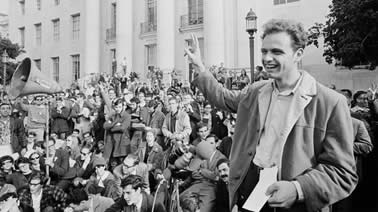 This movement was a student protest which took place during the 1964–65 academic year on the campus of the University of California, Berkeley under the informal leadership of students Mario Savio, Jack Weinberg, Michael Rossman, Brian Turner, Bettina Aptheker, Steve Weissman, Art Goldberg, Jackie Goldberg, and others. In protests unprecedented in scope, students insisted that the university administration lift the ban of on-campus political activities and acknowledge the students’ right to free speech and academic freedom.
This movement was a student protest which took place during the 1964–65 academic year on the campus of the University of California, Berkeley under the informal leadership of students Mario Savio, Jack Weinberg, Michael Rossman, Brian Turner, Bettina Aptheker, Steve Weissman, Art Goldberg, Jackie Goldberg, and others. In protests unprecedented in scope, students insisted that the university administration lift the ban of on-campus political activities and acknowledge the students’ right to free speech and academic freedom.
Civil Rights
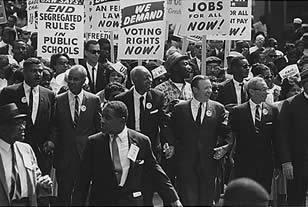 This movements goals were to end racial segregation and discrimination against African Americans and to secure legal recognition and federal protection of the citizenship rights enumerated in the Constitution and federal law. This movement was strongest between 1954 and 1968, particularly in the South.
This movements goals were to end racial segregation and discrimination against African Americans and to secure legal recognition and federal protection of the citizenship rights enumerated in the Constitution and federal law. This movement was strongest between 1954 and 1968, particularly in the South.
The leadership was African American, and much of the political and financial support came from labor unions, major religious denominations, and prominent white Democratic Party politicians such as Hubert Humphrey and Lyndon B. Johnson and white Republican Party politicians such as Governor Nelson Rockefeller and Senator Everett Dirksen.
The movement was characterized by major campaigns of civil resistance. Between 1955 and 1968, acts of nonviolent protest and civil disobedience produced crisis situations and productive dialogues between activists and government authorities.
Swinging London
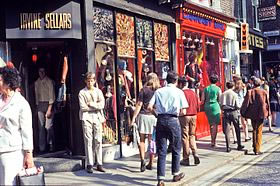 This was another movement, and is a catch-all term applied to the fashion and cultural scene that flourished in London in the 1960s. It consisted largely of music, discothèques, and mod fashion. Swinging London was a phenomenon that mainly occurred with youth and that emphasized the new and modern.
This was another movement, and is a catch-all term applied to the fashion and cultural scene that flourished in London in the 1960s. It consisted largely of music, discothèques, and mod fashion. Swinging London was a phenomenon that mainly occurred with youth and that emphasized the new and modern.
“Swinging London” was defined by Time magazine in its issue of 15 April 1966 and celebrated in the name of the pirate radio station of the same name. The union jack flag became a symbol of this movement. The Beatles and The Kinks were music that figured prominently in this movement and contributed to another movement, the British Invasion.
British Invasion
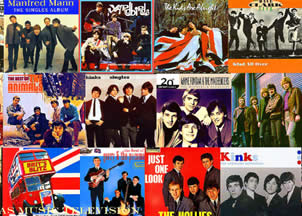 This movement was a phenomenon that occurred in the mid-1960s when rock and pop music acts from the United Kingdom, as other aspects of British culture, became popular in the United States, and significant to the rising “counterculture” on both sides of the Atlantic. Pop and rock groups such as the Beatles, the Dave Clark Five, The Kinks, The Rolling Stones, Herman’s Hermits, the Animals, and the Who were at the forefront of the invasion.
This movement was a phenomenon that occurred in the mid-1960s when rock and pop music acts from the United Kingdom, as other aspects of British culture, became popular in the United States, and significant to the rising “counterculture” on both sides of the Atlantic. Pop and rock groups such as the Beatles, the Dave Clark Five, The Kinks, The Rolling Stones, Herman’s Hermits, the Animals, and the Who were at the forefront of the invasion.
The leadership was African American, and much of the political and financial support came from labor unions, major religious denominations, and prominent white Democratic Party politicians such as Hubert Humphrey and Lyndon B. Johnson and white Republican Party politicians such as Governor Nelson Rockefeller and Senator Everett Dirksen.
The movement was characterized by major campaigns of civil resistance. Between 1955 and 1968, acts of nonviolent protest and civil disobedience produced crisis situations and productive dialogues between activists and government authorities.
Flower Power
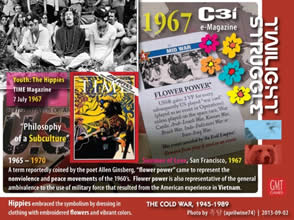 Flower power was another counterculture movement and was a slogan used during the late 1960s and early 1970s as a symbol of passive resistance and non-violence ideology. It is rooted in the opposition movement to the Vietnam War.
Flower power was another counterculture movement and was a slogan used during the late 1960s and early 1970s as a symbol of passive resistance and non-violence ideology. It is rooted in the opposition movement to the Vietnam War.
The expression was coined by the American beat poet Allen Ginsberg in 1965 as a means to transform war protests into peaceful affirmative spectacles. Hippies embraced the symbolism by dressing in clothing with embroidered flowers and vibrant colors, wearing flowers in their hair, and distributing flowers to the public, becoming known as flower children The term later became generalized as a modern reference to the hippie movement and the so-called counterculture of drugs, psychedelic music, psychedelic art and social permissiveness.
“Swinging London” was defined by Time magazine in its issue of 15 April 1966 and celebrated in the name of the pirate radio station of the same name. The union jack flag became a symbol of this movement. The Beatles and The Kinks were music that figured prominently in this movement and contributed to another movement, the British Invasion.
Summer of Love
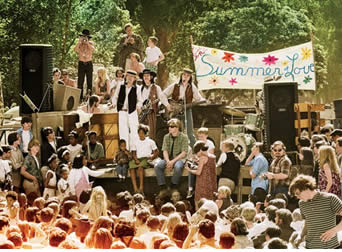 Ou Summer of Love was a social phenomenon that occurred during the summer of 1967, when as many as 100,000 people, mostly young people sporting hippie fashions of dress and behavior, converged in San Francisco’s neighborhood Haight-Ashbury. Although hippies also gathered in many other places in the U.S., Canada and Europe, San Francisco was at that time the most publicized location for hippie fashions.
Ou Summer of Love was a social phenomenon that occurred during the summer of 1967, when as many as 100,000 people, mostly young people sporting hippie fashions of dress and behavior, converged in San Francisco’s neighborhood Haight-Ashbury. Although hippies also gathered in many other places in the U.S., Canada and Europe, San Francisco was at that time the most publicized location for hippie fashions.
Hippies, sometimes called flower children, were an eclectic group. Many were suspicious of the government, rejected consumerist values, and generally opposed the Vietnam War. A few were interested in politics; others were concerned more with art (music, painting, poetry in particular) or religious and meditative practices.
The leadership was African American, and much of the political and financial support came from labor unions, major religious denominations, and prominent white Democratic Party politicians such as Hubert Humphrey and Lyndon B. Johnson and white Republican Party politicians such as Governor Nelson Rockefeller and Senator Everett Dirksen.
The movement was characterized by major campaigns of civil resistance. Between 1955 and 1968, acts of nonviolent protest and civil disobedience produced crisis situations and productive dialogues between activists and government authorities.
Monetary Pop Festival
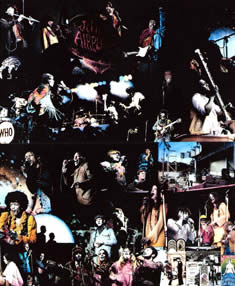 This festival was a three-day concert event held June 16 to June 18, 1967 in Monterey, CA. Crowd estimates for the festival have ranged from 25,000-90,000 people, who congregated in and around the festival grounds.
This festival was a three-day concert event held June 16 to June 18, 1967 in Monterey, CA. Crowd estimates for the festival have ranged from 25,000-90,000 people, who congregated in and around the festival grounds.
Festival-goers who wanted to see the musical performances were required to have either an ‘all-festival’ ticket or a separate ticket for each of the five scheduled concert events they wanted to attend in the arena: Friday night, Saturday afternoon and night, and Sunday afternoon and night. Ticket prices varied by seating area, and ranged from $3 to $6.50 ($21–46, adjusted for inflation). The festival is remembered for the first major American appearances by Jimi Hendrix, The Who and Ravi Shankar. Also performing were Janis Joplin and Otis Redding. This festival embodied the theme of this counter culture movement.
Woodstock
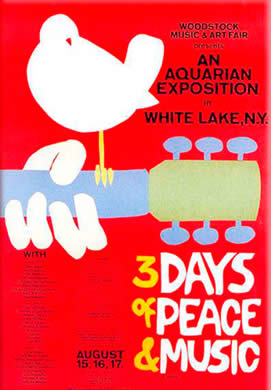 Another festival that embodied the counter culture movement was a music festival attracting an audience of over 400,000 people, scheduled over three days on a dairy farm in New York from August 15 to 17, 1969, but which ran over four days to August 18, 1969. During the sometimes rainy weekend, 32 acts performed outdoors before an audience of 400,000 people. It is widely regarded as a pivotal moment in popular music history, as well as the definitive nexus for the larger counterculture generation.
Another festival that embodied the counter culture movement was a music festival attracting an audience of over 400,000 people, scheduled over three days on a dairy farm in New York from August 15 to 17, 1969, but which ran over four days to August 18, 1969. During the sometimes rainy weekend, 32 acts performed outdoors before an audience of 400,000 people. It is widely regarded as a pivotal moment in popular music history, as well as the definitive nexus for the larger counterculture generation.
Hippies, sometimes called flower children, were an eclectic group. Many were suspicious of the government, rejected consumerist values, and generally opposed the Vietnam War. A few were interested in politics; others were concerned more with art (music, painting, poetry in particular) or religious and meditative practices.
The leadership was African American, and much of the political and financial support came from labor unions, major religious denominations, and prominent white Democratic Party politicians such as Hubert Humphrey and Lyndon B. Johnson and white Republican Party politicians such as Governor Nelson Rockefeller and Senator Everett Dirksen.
The movement was characterized by major campaigns of civil resistance. Between 1955 and 1968, acts of nonviolent protest and civil disobedience produced crisis situations and productive dialogues between activists and government authorities.
